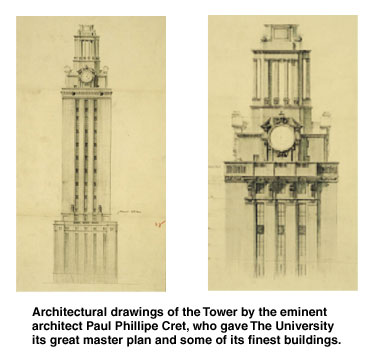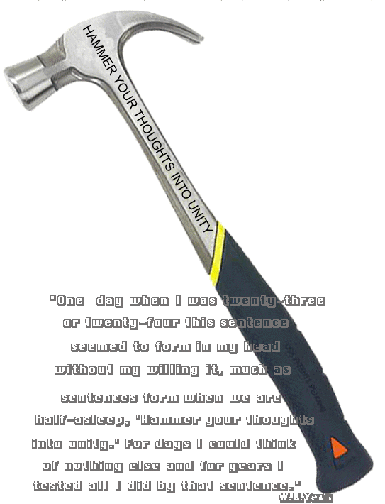
‘One
day when I was twenty-three or twenty-four this sentence seemed to
form in my head, without my willing it, much as sentences form when we are
half-asleep, ‘Hammer your thoughts into unity’.
For days I could think of nothing else and for years I tested all I did by that
sentence [...]” William Butler Yeats (cited in Frank Tuohy, Yeats, 1976,
p.51 )
Learning Record Instructions
A.1.
Take the psychological “type” test of the Meyers-Briggs variety, such as that at http://www.humanmetrics.com/cgi-win/JTypes1.htm
Print out the results and include them in your document. Then check out the descriptions of the related learning styles in our course anthology and add a evaluation of at least 300 words of how well you believe "your" learning and writing styles describe you as a reader and writer.
A.2.
500 words or more of your reflections on your own development as a reader and writer, especially in relation to your thoughts and feelings about the goals and themes of the course.
Goals list.
Make a numbered list of your own personal goals in the course, explaining your choices as you go along. 300 words or more. Make sure the list of goals focuses on your education in this course, not, say, getting a job for the summer, relating better to my boy/girlfriend, roommate, etc. You might want to consult our course goals at some point in the process. Attach a copy of this numbered list to every subsequent LR assignment, including the Midterm and the Final.
Learning Record at mid term and end of term.
In general, when a Learning Record Observation is due you will write about your development in the course. You will include, as a separate document, your latest list of goals. You will notice the word “latest” because you may revise them as you go along. If you do, make sure to show how you revised them in the updated list.
However, now at the middle and end of the term you will especially want to be reflective, increasing your consciousness of your highest aspirations as well as your own learning styles, creative processes. A key to this awareness is to incorporate quotes from Ram Dass's The Witness (in your course anthology). Points will be deducted if you don't integrate at least two of these quotations in the LR Midterm.
Dass should help you get the perspective you need to answer some of the big questions, such as What pilgrimage am I on? What truths do I think will set me free?
PICTURES. Because visual rhetoric is a component of the grade for the course, you will get points for all pictures you include related to yourself in the course that are integrated into the discussion in the text, central to your self reflection, and discussed in it. You may choose, of course, from all pictures of you in groups as well as all individual pictures of you and of work you have done, such as drawings or road maps. (Select "Class Pictures" on our course website and then go through the folders identifying those that include you and then downloading them. As you write, incorporate the pictures (in color) in your text where they are discussed.The purpose of the pictures, of course, is for you to stand outside yourself and see yourself as others see you. Hence you must actually discuss what you see in the picture. All pictures are to be placed in the text where they are most relevant. None are to be placed at the end in a gallery or whatever. In the LR Midterm you earn up to three points per picture to a total maximum of ten points. In the LR Final you earn up to two points per picture to a total maximum of twenty points.
QUOTATIONS. As always you will get points for quotations, but now, to make these assignments a little like a take-home final exam, the emphasis will be on incorporating quotes from as many different reading assignments as possible from our course. You can quote more than once from one source but the first quote will be worth more. You can also quote from sources other than those assigned, but again these quotes will not be worth as much as the first quote from an assigned text. In the LR Midterm the first quote from a text earns up to three points, the second up to two points, with a maximum of twenty points. In the LR Final the first quote earns up to two points, the second one, with a maximum of thirty points.


LR Midterm.
This is an Observation (see above) of at least eleven-hundred words (three pages or so) of your pilgrimage, your truths as you know them now; other truths, skills, character traits you may be seeking; and how they all relate to your own learning styles and creative processes. Your awareness of how you learn and create also provides you with knowledge of your limitations, some of the blocks that stand in your way in your pilgrimage. (However, this is NOT to be an expanded version of your goals list -- that is to remain a separate document.) The emphasis now is on connection, composition, coherence, hammering your thoughts into unity, and that will probably be made very difficult if you just use your numbered goals as the organizational structure of your self-reflection. Remember to incorporate in your LR Midterm at least two quotes from Ram Dass's The Witness (in your course anthology): points will be deducted for less than two quotations. Dass quotes are rewarded but not required for the LR Final.

The focus on ultimate truths and your pilgrimage is inspired by the seal of the university which features a Latin version of this statement of Mirabeau B. Lamar, second President of the Republic of Texas: "The cultivated mind is the guardian genius of democracy, and, while guided and controlled by virtue, [it is] the noblest attribute of man. It is the only dictator that freemen acknowledge, and the only security which freemen desire." The goal of a "cultivated mind ... guided and controlled by virtue" reminds us that composing a self, building character, is the traditional focus of a college education. John Henry Newman in The Idea of a University (1852) puts it this way:
When the intellect has once been properly trained and formed to have a connected view or grasp of things, it will display its powers with more or less effect according to its particular quality and capacity in the individual. In the case of most men [and women] it makes itself felt in the good sense, sobriety of thought, reasonableness, candour, self-command, and steadiness of view, which characterize it. In some it will have developed habits of business, power of influencing others, and sagacity. In others it will elicit the talent of philosophical speculation, and lead the mind forward to eminence in this or that intellectual department. In all it will be a faculty of entering with comparative ease into any subject of thought, and of taking up with aptitude any science or profession. ... He profits by an intellectual tradition, which is independent of particular teachers, which guides him in his choice of subjects, and duly interprets for him those which he chooses. He apprehends the great outlines of knowledge, the principles on which it rests, the scale of its parts, its lights and its shades, its great points and its little, as he otherwise cannot apprehend them. Hence it is that his education is called "Liberal." A habit of mind is formed which lasts through life, of which the attributes are, freedom, equitableness, calmness, moderation, and wisdom.... Moreover, such knowledge is not a mere extrinsic or accidental advantage, which is ours today and another's tomorrow, which may be got up from a book, and easily forgotten again, which we can command or communicate at our pleasure, which we can borrow for the occasion, carry about in our hand, and take into the market; it is an acquired illumination, it is a habit, a personal possession, and an inward endowment.

Lamar's statement appears on the ceiling of the Hall of Noble Words in the Tower next to this one by the first President of the Republic of Texas, Sam Houston: "The benefits of education and of useful knowledge, generally diffused through a community, are essential to the preservation of a free government." Houston's distinction between education and useful knowledge was a common one in the nineteenth century. Newman stresses that "education is a higher word; it implies an action upon our mental nature, and the formation of a character; it is something individual and permanent, and is commonly spoken of in connexion with religion and virtue." Newman elucidates not only Houston's statement, but also Lamar's stress on a "cultivated mind ... guided and controlled by virtue."

In other words, the State of Texas is investing in your education because your leadership is essential to maintaining democracy in this state and nation.






The official "Core Purpose of the University" is " To transform lives for the benefit of society," and your life, and the lives of those you lead, are to be transformed specifically by six core values: "Discovery, Freedom, Leadership, Individual Opportunity, and Responsibility."

One of the most important character traits we want to acquire and demonstrate is "Leadership: The will to excel with integrity and the spirit that nothing is impossible. 'A university both leads and is a catalyst for leadership. By its creation, expansion, and transmission of knowledge, a university leads society to beneficial changes. University faculty both demonstrate and teach leadership to new generations of students. The quality of a university's leadership helps to determine the quality of our culture. The University's challenge is to provide informed, ethical, compassionate, and respectful leadership'. Larry Temple, BBA '57; President, Ex-Students' Association 1997-1998."
http://www.utexas.edu/supportut/core_values/leadership.html

Your subject is your self-transformation, your acquisition of character traits such as "informed, ethical, compassionate, and respectful leadership." Your pilgrimage toward this and other goals is your subject. Hence your composition may well include a statement of the truth[s] that you seek, and/or have found, that set you free.

As the image of the scallop shell below the motto on the tower reminds us, particularly important are pilgrimage goals that can endow you with a compelling vision that inspires others to follow you. Hence especially valuable are truths that tap into that which is greater than the self, truths that enable you to make a contribution to society that can be thought of as your legacy when you are gone. Think back to yourself as a freshman; as Newman says " when he is leaving for the University, he is mainly the creature of foreign influences and circumstances, and made up of accidents, homogeneous or not, as the case may be." Then, if she or he is a good student, she will have experienced at least one "sensation which perhaps he never had before. He has a feeling not in addition or increase of former feelings, but of something different in its nature. He will perhaps be borne forward, and find for a time that he has lost his bearings. He has made a certain progress, and he has a consciousness of mental enlargement; he does not stand where he did, he has a new centre, and a range of thoughts to which he was before a stranger... We seem to have new faculties, or a new exercise for our faculties, by this addition to our knowledge; like a prisoner, who, having been accustomed to wear manacles or fetters, suddenly finds his arms and legs free. ... But now every event has a meaning; they have their own estimate of whatever happens to them; they are mindful of times and seasons, and compare the present with the past; and the world, no longer dull, monotonous, unprofitable, and hopeless, is a various and complicated drama, with parts and an object, and an awful moral." Consider to what extent you have transcended the accidents of being born in a particular place and time, molding your own character, finding your own truths that set you free.
Now, what you would say to a visitor if you were a ghostly alumnus in the MOO and were asked 'What is your dream?'
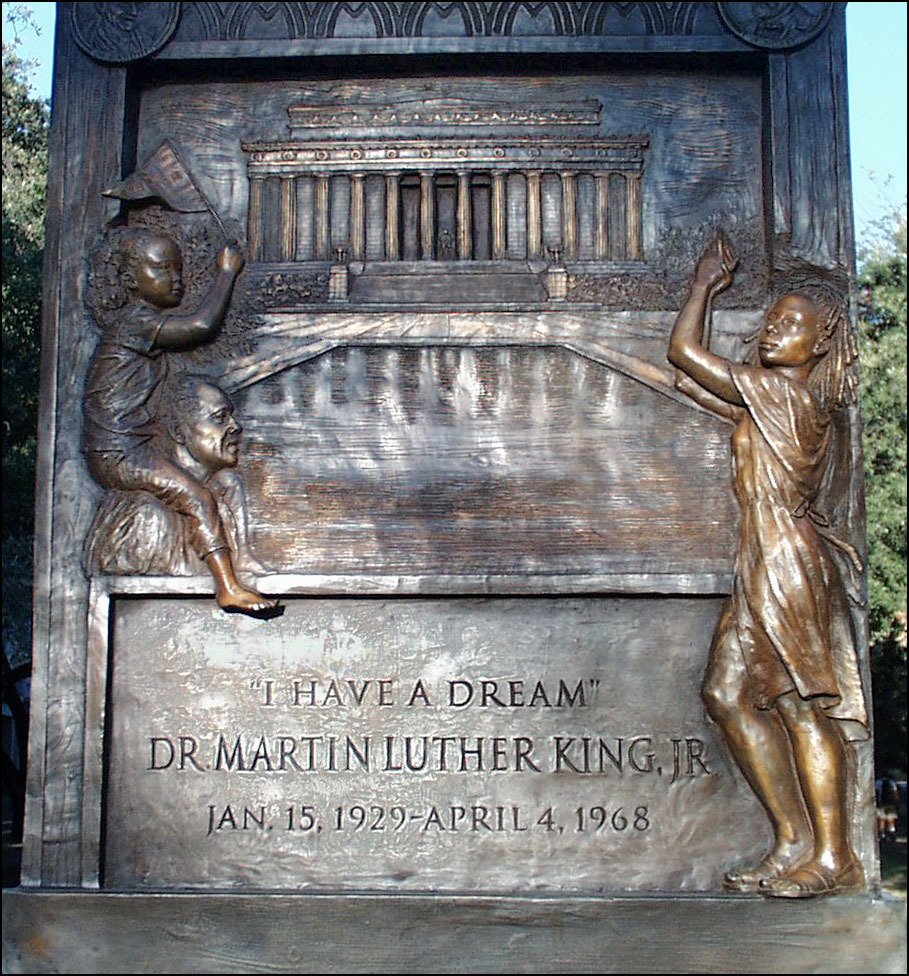
What would the torch represent that you want to pass on to the next generation?
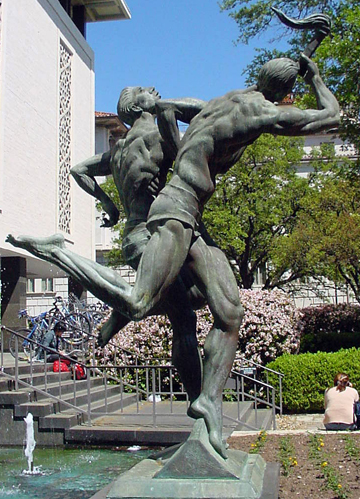
What would advice would you, as the old cowboy in the sculpture, Generations, in front of the Texas Exes, say to the next generation?
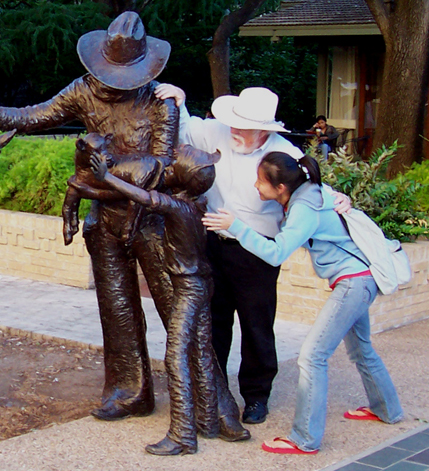
In short, what, in your words, is the spirit of the University of Texas at Austin? In Newman's words, "It will give birth to a living teaching, which in course of time will take the shape of a self-perpetuating tradition, or a genius loci, as it is sometimes called; which haunts the home where it has been born, and which imbues and forms, more or less, and one by one, every individual who is successively brought under its shadow."
Reflect on the semester and your college education, and using one or more of these unifying themes,
“Only Connect,"* "Hammer your thoughts into unity.”
As you compose this essay, you will be hammering your self into unity. The word "compose" connects "pose," that is "to place," to "con" ("together"), and its root meaning is thus "to place together," "To put together (parts or elements) so as to make up a whole" (O.E.D.). As Newman puts it, your mind takes a" connected view of old and new, past and present, far and near, and ... has an insight into the influence of all these one on another; without which there is no whole, and no centre. It possesses the knowledge, not only of things, but also of their mutual and true relations." Such a mind "makes every thing in some sort lead to every thing else; it would communicate the image of the whole to every separate portion, till that whole becomes in imagination like a spirit, every where pervading and penetrating its component parts, and giving them one definite meaning. Just as our bodily organs, when mentioned, recall their function in the body, as the word "creation" suggests the Creator, and "subjects" a sovereign, so, in the mind of the Philosopher, as we are abstractedly conceiving of him, the elements of the physical and moral world, sciences, arts, pursuits, ranks, offices, events, opinions, individualities, are all viewed as one, with correlative functions, and as gradually by successive combinations converging, one and all, to the true centre."
When you have composed yourself in this way, save your LR Midterm as a web page and upload your composition, with pictures, to your webspace. Post the link on the relevant Discussion Board like you did your first project. Respond to the LR Midterms of others and then revise your own essay responding to their suggestions. Make sure you have a word count, page nos., and have avoided all the errors and infelicities the instructor marked on your project because penalties will be doubled for making the same errors again. Turn in the hard copy to the instructor in a folder with [1] both versions of your project graded by the instructor, with his comments on them, [2] your updated goals list.
When you get your LR Midterm back, revise again, adding at least 350 new words, highlighting absolutely all changes, including every punctuation change, and hand it in again, along with the first version with his comments, in the same folder with the same documents. Also include in this folder the CD htm version of your project with pictures and the 350 new words and all the changes, but without the highlighting. As you did for the revision of your first project, put this htm version of your midterm on a CD with the related picture files. Test it to make sure selecting the htm file not only brings up the text but also the pictures without making any reference to webspace or any other internet site.
You will probably expand your revised midterm to create the LR Final. For that reason especially, make sure that the final revised version of the midterm has enough examples and details to make the meanings of the abstractions clear and, most important of all, that it shows that you have HAMMERED YOUR THOUGHTS INTO UNITY.
LR Final.

Title an essay of at least 2500 additional words (seven pages or so).The word "additional" indicates that you could simply expand your LR Midterm from four pages to eleven pages or so (at least 4000 words if combined). (If you choose to do the LR Final as a completely separate composition, of course you can not count material already covered in the LR Midterm toward your point total of 2500 words.)
In any case, if you can (though they are no longer required), incorporate quotes from Ram Dass's The Witness, in your course anthology. Most relevant here might be Dass's discussion of seeing yourself from above, as if you were moving around in a small town. You might even consider how you think God sees you.
This is your final evaluation of pilgrimage and your truths as you know them at this time. Yet this remains exploratory writing and the tendency to describe your truths in vague abstractions will be even greater in this more ample space. The best you can hope for from the reader with abstractions alone is what Newman called "notional assent," assent to an idea. If you want "real assent" you must climb down the ladder of abstractions as often as possible to provide examples, metaphors, etc. As Newman said, " "the heart is commonly reached, not through the reason, but through the imagination, by means of direct impressions, by the testimony of facts and events, by history, by description. Persons influence us, voices melt us, looks subdue us, deeds inflame us" (A Grammar of Assent).
Multimedia helps evoke real assent. Follow the instructions for including pictures (above) and quotations for the LR Midterm. Now, of course, there will probably be more pictures and quotes.
If you can do so without weakening coherence and unity, perhpas judge how well you have met the goals you set out in previous LR documents, especially what skills, ways of knowing and being, etc. you wanted to acquire.
In the process, integrate your road map, and, if they do not weaken your unity, any drawings, if relevant, and any parts of previous LR documents that seem particularly relevant to your unifying themes.
If it connects to your themes, evaluate the course in terms of what worked for you and what did not, maybe making suggestions for class activities or for the professor to better support learning and meeting goals like yours in future versions of the course.
Add page nos. and a word count. Make sure you have avoided all the errors and infelicities the instructor marked on your project because penalties will be tripled for making the same errors again.
Turn in the LR final hard copy to Par 132 during the specified time or before, keeping a copy for your portfolio. Turn in the hard copy in a folder with [1] both versions of your project graded by the instructor, with his comments on them, [2] your updated goals list, [3,4] and your LR Midterm and your revised LR Midterm, both with instructor comments, [5] a CD with the LR Final in htm format and with all associated picture files. Do not turn in the LR Final unless you have the CD and HAVE USED A BROWSER TO OPEN THE MAIN HTM FILE AND ARE SURE THE PICTURES ARE COMING UP WITH THE MAIN HTM FILE. As with the revised LR Midterm, YOU WILL NOT RECEIVE A GRADE FOR THE LR FINAL WITHOUT THE WORKING CD.
(Here are the relevant directions from the project instructions for "saving as a web page." Once you have done that with your Word document follow these documents with one change: where you see "upload" substitute "copy to your CD."
"The one you're looking for is "(filename).htm," so if your file is called "project1," the file you want is called "project1.htm." When this file is uploaded, you will have uploaded the written part of the project, but not the pictures.
5. When you saved the project in ".htm" format, Word also created a folder with the same name as your project to hold the multimedia files (read "pictures"). The default name of this folder is "(filename)_files"; (using the previous example it would be "project1_files").
*Here is an example of an unlikely though rather abstract connection: an excerpt from the web page devoted to leadership that integrates our focus on campus architecture:
"Throughout its history, The University has moved forward in cycles. At times, the hard work of the UT community, the fortunes of our state and the leadership of those who love Texas have all come together to foster periods of great advancement. With the creation of the Permanent University Fund (PUF) in the 1930s, ten new buildings were funded at once, including some of our most beloved structures — the Texas Union, Goldsmith Hall, Mary Gearing Hall, the Hogg Building and, of course, the Main Building and Tower. These magnificent buildings formed the basis for the campus as we know it today."
